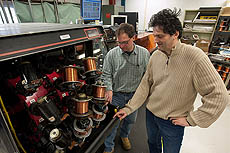| Friday, April 8, 2011 |
| Subscribe | Contact Fermilab Today | Archive | Classifieds |
Feature
|
Superconductivity: Happy Anniversary!
One hundred years ago, in April 1911, Dutch scientist Kamerlingh Onnes discovered superconductivity. While investigating the electrical resistance of pure mercury at very low temperatures, Onnes discovered that mercury's resistance dropped suddenly to zero in the vicinity of 4.2 Kelvin (see graphic). Scientists found that similar transitions happened in other metals and dubbed the phenomenon superconductivity. Since 1911, we have discovered superconductors among chemical elements, alloys, ceramics and organic materials that can carry very strong electric currents without electrical resistance. These materials are perfect for developing powerful magnets and other applications. Their development and our improved understanding of superconductivity have paved the way for applications such as superconducting magnets in accelerators, MRI devices and levitating trains; various electrical power applications; and new particle acceleration devices known as superconducting radio-frequency cavities. Fermilab has a long history of forefront research in the field of superconducting accelerator magnets. In addition, the laboratory has been involved in developing and testing superconducting RF cavities made of niobium for many years (see this article in Symmetry magazine. The Superconductor R&D Group in the Technical Division's Magnet Systems Department works on new materials and technologies for superconducting accelerator magnets for various Fermilab and multi-laboratory projects. It has the equipment and expertise needed for cable fabrication, small coil winding, strand and cable testing, strand processing and material studies. Our experts work closely with industry to improve the superconductor's performance and collaborate with other laboratories and universities to improve the fundamental understanding of strands, cables and magnets. The outcome of this work provides material specifications and engineering data for accelerator magnet design and construction.
For the LHC luminosity upgrades, we are developing robust and cost-effective accelerator magnets with 11-15 Tesla magnetic fields. We are using niobium-three-tin (Nb3Sn), a low-temperature superconductor that is widely used for high-field solenoids and other types of magnets in fusion, solid-state physics and other fields of research. This material can produce stronger magnetic fields than the niobium-titanium conductor used in the Tevatron and LHC magnets, but it requires a completely different magnet fabrication technology. We also have worked with niobium-three-aluminum. In 2010, Fermilab scientists and their collaborators in Japan won the prestigious Superconductor Science and Technology Prize for their investigation of a highly strain-tolerant Nb3Al cable. This work continues in collaboration with CERN. Our long-term goals include superconducting magnets with magnetic fields above 20 Tesla for a possible Muon Collider and LHC energy upgrades. Such magnets will require materials outside of the niobium family. Our group is studying high-temperature superconductors such as Bi-2212 round wires and YBCO tapes. This work has the potential for very high impact on the future Energy Frontier activities in high-energy physics. Thank you, Dr. Onnes, for getting this all started. In your honor, various organizations will host events across the world. -- Emanuela Barzi |

